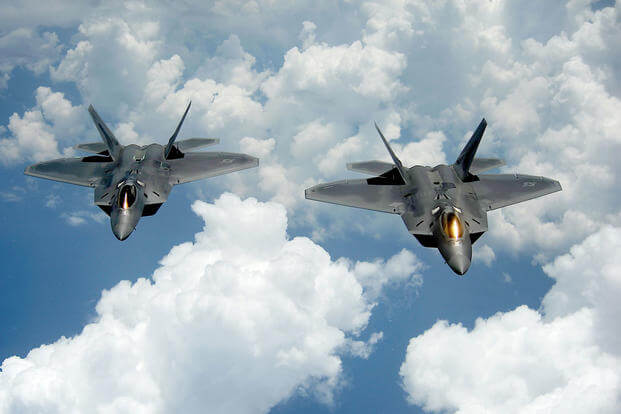LE BOURGET, France -- Air Force Secretary Deborah James said the U.S. could deploy a squadron of F-22 Raptor fighter jets to Europe in response to the stepped-up aggression by Russia in the region.
She listed Russia as the "biggest threat on my mind" when she was asked by a reporter at the Paris Air Show to list the greatest threat faced by the U.S. Air Force.
"I would say the biggest threat on my mind is what's happening with Russia and the activities of Russia, and indeed that's a big part of why I'm here in Europe and having those discussions," she said. "It's extremely worrisome on what's going on in the Ukraine. We've seen the type of warfare, which someone dubbed it hybrid warfare, which is somewhat new. So I would put that at the top of my list."
The Air Force has responded by sending two theater security packages made up of A-10s and F-15Cs to Europe. Those two units are scheduled to spend six months in Europe flying missions across the continent.
About 300 airmen deployed on Feb. 13 with the 12 A-10s from the 355th Fighter Wing based out of Davis-Monthan Air Force Base, Ariz. Twelve F-15Cs with the Florida National Guard arrived in Europe a month later.
James said more units would take part in the rotational forces to Europe -- possibly even an F-22 unit.
"I could easily see the day -- though I couldn't tell you the day exactly -- when the F-22, for example, rotates in is a possibility. I don't see why that couldn't happen in the future," James said.
Gen. Frank Gorenc, commander of U.S. Air Forces in Europe, said in the past, his command had not received the priority necessary to receive a theater security package because of pressing needs elsewhere.
"Prior to the Ukraine, we were not able to get theater security packages because of other priorities in the world, but this year we were able to prioritize two theater security packages," he said.
The theater security packages are deployed for six months. Gorenc did not say who the Air Force might send to Europe next, or when.
The Air Force does not plan on increasing the level of assignment manning in Europe in response to Russia. Currently, the U.S. has 65,000 active-duty service members stationed in Europe, with the majority made up of airmen and soldiers.
The Air Force secretary, however, did not rule out increasing the assigned head count.
"It's always a possibility, but there's no plan at this time to do that. The plan at this time is to do increased levels of rotations," James said.
James is planning on holding meetings with a host of NATO allies at the Paris Air Show before traveling to U.S. Air Force units across USAFE.
She said she is talking with allied leaders about maintaining defense spending while also reassuring those NATO allies that they will receive support from the U.S. in light of Russia's aggressive tactics.
"We continue to urge all our NATO allies to hit that target that we've all committed to, 2 percent," James said. "We don't know everyone's doing it, but we continue to press."
-- Michael Hoffman can be reached at Mike.Hoffman@military.com.



























